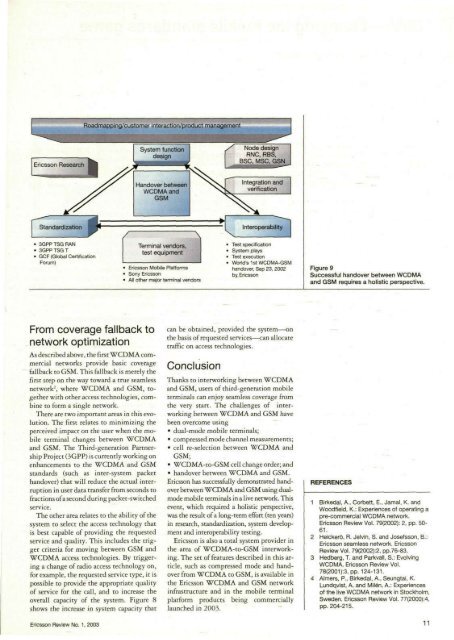ericssonhistory.com
ericssonhistory.com
ericssonhistory.com
- No tags were found...
Create successful ePaper yourself
Turn your PDF publications into a flip-book with our unique Google optimized e-Paper software.
Figure 9Successful handover between WCDMAand GSM requires a holistic perspective.From coverage fallback tonetwork optimizationAs described above, the first WCDMA <strong>com</strong>mercialnetworks provide basic coveragefallback to GSM. This fallback is merely thefirst step on the way toward a true seamlessnetwork 2 , where WCDMA and GSM, togetherwith other access technologies, <strong>com</strong>bineto form a single network.There are two important areas in this evolution.The first relates to minimizing theperceived impact on the user when the mobileterminal changes between WCDMAand GSM. The Third-generation PartnershipProject (3GPP) is currently working onenhancements to the WCDMA and GSMstandards (such as inter-system packethandover) that will reduce the actual interruptionin user data transfer from seconds tofractions of a second during packet-switchedservice.The other area relates to the ability of thesystem to select the access technology thatis best capable of providing the requestedservice and quality. This includes the triggercriteria for moving between GSM andWCDMA access technologies. By triggeringa change of radio access technology on,for example, the requested service type, it ispossible to provide the appropriate qualityof service for the call, and to increase theoverall capacity of the system. Figure 8shows the increase in system capacity thatcan be obtained, provided the system—onthe basis of requested services—can allocatetraffic on access technologies.ConclusionThanks to interworking between WCDMAand GSM, users of third-generation mobileterminals can enjoy seamless coverage fromthe very start. The challenges of interworkingbetween WCDMA and GSM havebeen over<strong>com</strong>e using• dual-mode mobile terminals;• <strong>com</strong>pressed mode channel measurements;• cell re-selection between WCDMA andGSM;• WCDMA-to-GSM cell change order; and• handover between WCDMA and GSM.Ericsson has successfully demonstrated handoverbetween WCDMA and GSM using dualmodemobile terminals in a live network. Thisevent, which required a holistic perspective,was the tesult of a long-term effort (ten years)in research, standardization, system developmentand interoperability testing.Ericsson is also a total system provider inthe area of WCDMA-to-GSM interworking.The set of features described in this article,such as <strong>com</strong>pressed mode and handoverfrom WCDMA to GSM, is available inthe Ericsson WCDMA and GSM networkinfrastructure and in the mobile terminalplatform products being <strong>com</strong>merciallylaunched in 2003.REFERENCESBirkedal, A., Corbett, E., Jamai, K. andWoodfield, K.: Experiences of operating apre-<strong>com</strong>mercial WCDMA network.Ericsson Review Vol. 79(2002): 2, pp. 50-61.Heickero, R. Jelvin, S. and Josefsson, B.:Ericsson seamless network. EricssonReview Vol. 79(2002):2, pp.76-83.Hedberg, T. and Parkvall, S.: EvolvingWCDMA. Ericsson Review Vol.78(2001 ):3, pp. 124-131.Aimers, P., Birkedal, A., Seungtai, K.Lundqvist, A. and Milen, A.: Experiencesof the live WCDMA network in Stockholm,Sweden. Ericsson Review Vol. 77(2000):4,pp. 204-215.Ericsson Review No. 1, 2003 11















